Doesn't it seem like as soon as the weather turns cooler you just want to turn the oven on? Well, the weather started changing around here around the middle of October and sure enough I spent two Saturdays in a row baking lovely things for breakfast and sharing. The warm sweet aromas coming out of the oven and the occasional burst of bright sunshine through the orange and red leaves makes fall a not so bad time of year after all.
Making sweets or baked goods while following a traditional foods lifestyle can be challenging for a couple of reasons. Evidence is stacking up from all sides that sugar and simple carbohydrates in refined flour are just not good for you. Sally Fallon recommends the use of rapadura, an unrefined cane sugar, instead of refined white sugar or adapting a recipe to use honey or maple syrup. These sweetners, while still very high in sucrose and fructose that can wreck havoc on all but the very most stable blood sugar levels, do contain some of the trace nutrients of the original plant material. Traditional wisdom reminds us that tempering our sweets with adequate fats can help regulate our blood sugar so I always try to include nutritious ingredients and a full compliment of butter, eggs or coconut oil.
The other problem with baking is the problem of grains. Sally Fallon teaches us that though whole grains are more nutritious than refined grains, they need to be processed properly in order to neutralize anti-nutrients and release their full potential. The usual methods for neutralizing phytates are soaking in an acidic medium, sprouting or fermenting using sourdough methods. I won't even get into gluten free baking, oy! Sprouted flour can be used in any recipe that calls for wheat flour with minimal or no changes to the process. Soaking and fermenting require completely different processes and honestly, are a bit outside my range of motion on a typical Saturday morning. I take comfort in the knowledge that white flour, though not adding much nutrition, is not removing vital minerals through the action of phytic acid. My baked goods are treats, not staples in my diet, and so I don't worry too much.
This recipe, though, circumvents most of these problems by being grain free and refined sugar free. It is based on a recipe in the great cookbook White Trash Cooking by Ernest Matt Mickler, a lovely collection of authentic recipes reminiscent of the author's childhood in rural Mississippi. The original is called Sweet Potato Pone and is a mix of baked sweet potatoes, heavy cream, molasses and eggs baked into a sweet treat. I subsituted the sweet potato for canned pumpkin and the heavy cream for coconut milk to make a healthful, easy baked treat for any Saturday morning.
Pumpkin Molasses Custard (or Pone, if you prefer)
1 can canned pumpkin (or 2 cups mashed cooked pumpkin, winter sqash or sweet potato)
1/2 can coconut milk (or 1 cup heavy cream or evaporated milk)
3 eggs (or 2, if that's all you got)
1/2 cup molasses (give or take - a big hearty glugg out of the jar will do)
spices to taste - I used 2 tsp cinnamon. Nutmeg, ginger or cloves are not out of place here.
1/2 tsp salt
Combine everything in a mixing bowl and then pour into a greased 8x8 baking dish. Bake at 350 degrees for 40 to 50 minutes or until set and browned to your liking. It really can be eaten anywhere from still a little jiggly to brown and firm so take it out whenever you just can't stand it anymore.
Serve with whipped cream, cold heavy cream, chopped nuts or just a spoon. It's very rich but very tasty.
What do you like to bake up on these cool, rainy, autumn mornings?
Showing posts with label soaked flour. Show all posts
Showing posts with label soaked flour. Show all posts
Monday, November 8, 2010
Saturday Baking
Labels:
baking,
breakfast,
coconut,
coconut milk,
egg,
fat,
pumpkin,
recipe,
soaked flour
Sunday, March 22, 2009
Blender Batter: Cornbread
You know what's the worst? The absolute pits? When you put stuff in your crock pot in the morning, spend all day thinking about the food you are going to eat when you get home, arrive home only to find that your crock pot didn't cook your food for whatever reason. Sometimes that reason is that your darling boyfriend "forgot" to turn it on like you asked him, sometimes that reason is that your janky house has janky outlets and there was never power to the crock pot. Sometimes you were just in such a rush in the morning that you put everything in but didn't turn the darn thing on. No matter the reason, it totally sucks.
When this happened to me last week I did, at least, have one shining beacon of hope. In addition to putting black beans in the crock pot I had started a batch of Sue Gregg's Blender Batter Cornbread. You knew the blender batter method made great pancakes (because I told you it did and you all ran out and tried it this weekend, right?) but did you know it makes an amazing cornbread too? It does! Sue's recipe calls for whole kernel corn and wheat berries processed the same way as for the blender batter pancakes. I didn't have any wheat berries in the house so I used white flour, which is lower in phytates than whole wheat (if you are really worried about phytates in the corn and wheat then be sure to use wheat the way Sue recommends. Amanda Rose of Rebuild from Depression gives some compelling research results that corn does not have the phytase necessary to actually break down the phytic acid on it's own).
phytates in the corn and wheat then be sure to use wheat the way Sue recommends. Amanda Rose of Rebuild from Depression gives some compelling research results that corn does not have the phytase necessary to actually break down the phytic acid on it's own).
Be sure to check out Sue's recipe and then read on to see how I modified the recipe. Also, a chilling tale of new roommates gone awry, gnashing of teeth and flames. Seriously, keep reading.
2/3 cup coarse ground polenta
1 cup kefir, buttermilk or thinned yogurt
1/4 cup melted butter
2 eggs
2 tsp baking powder
1 tsp salt
1 cup unbleached white flour
*The night before combine the polenta and the kefir in a bowl. Stir to combine and leave to sit at room temperature over night.
*In the morning (afternoon or after work) pour the corn and kefir into y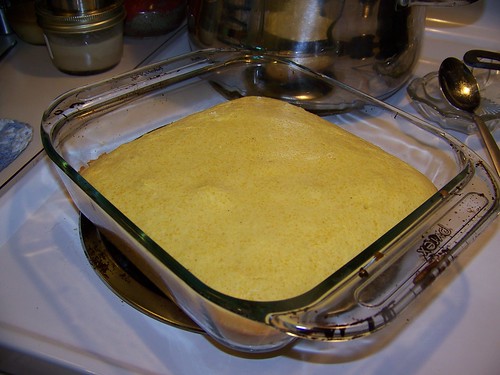 our blender and grind. Again, start slow and once the mixture is making a vortex then allow it to grind for a couple minutes. Add the eggs and blend then add the melted butter while the blender is running.
our blender and grind. Again, start slow and once the mixture is making a vortex then allow it to grind for a couple minutes. Add the eggs and blend then add the melted butter while the blender is running.
*Preheat the oven to 350 degrees. In a separate bowl combine the flour, baking powder and salt. Combine the wet ingredients from the blender with the dry ingredients in a medium sized mixing bowl. Stir until they are combined, but still lumpy. You don't want to overmix quick breads or they will be tough.
*Generously grease an 8x8 baking dish and pour the batter in. Cook at 350 for 25-30 minutes or until a knife stuck in the center comes out clean. Serve with lots of butter and honey.
My beans were a bust but the cornbread turned out perfect. It was golden, lightly browned, light textur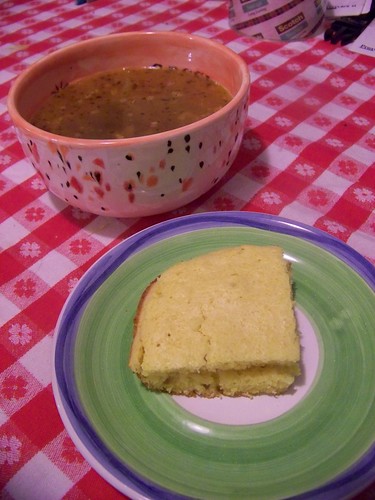 ed, deeply corn flavored. I whipped up a soup to eat instead of my beans, cut a piece of cornbread and sat down to dinner. As I was eating my new roommate came into the kitchen and started a pot of water for pasta. I will give him the benefit of the doubt and say our stove is set up strange but all I know is a few minutes later there was a pop like a gunshot. I turned around and the pyrex dish the cornbread had been cooked in was shattered and right before my eyes my beautiful cornbread caught on fire! He had turned the wrong burner on!!
ed, deeply corn flavored. I whipped up a soup to eat instead of my beans, cut a piece of cornbread and sat down to dinner. As I was eating my new roommate came into the kitchen and started a pot of water for pasta. I will give him the benefit of the doubt and say our stove is set up strange but all I know is a few minutes later there was a pop like a gunshot. I turned around and the pyrex dish the cornbread had been cooked in was shattered and right before my eyes my beautiful cornbread caught on fire! He had turned the wrong burner on!!
Damage control was quick and some of the cornbread was even salvaged. I was angry and upset for a minute or two (my cornbread!!) and then we got down to the business of digging pyrex shards out of the linoleum. My cornbread! My beautiful cornbread!!
Luckily, I have this awesome recipe, more polenta in the cupboard and my roommate's pyrex dish to cook it all in.
When this happened to me last week I did, at least, have one shining beacon of hope. In addition to putting black beans in the crock pot I had started a batch of Sue Gregg's Blender Batter Cornbread. You knew the blender batter method made great pancakes (because I told you it did and you all ran out and tried it this weekend, right?) but did you know it makes an amazing cornbread too? It does! Sue's recipe calls for whole kernel corn and wheat berries processed the same way as for the blender batter pancakes. I didn't have any wheat berries in the house so I used white flour, which is lower in phytates than whole wheat (if you are really worried about
 phytates in the corn and wheat then be sure to use wheat the way Sue recommends. Amanda Rose of Rebuild from Depression gives some compelling research results that corn does not have the phytase necessary to actually break down the phytic acid on it's own).
phytates in the corn and wheat then be sure to use wheat the way Sue recommends. Amanda Rose of Rebuild from Depression gives some compelling research results that corn does not have the phytase necessary to actually break down the phytic acid on it's own).Be sure to check out Sue's recipe and then read on to see how I modified the recipe. Also, a chilling tale of new roommates gone awry, gnashing of teeth and flames. Seriously, keep reading.
Blender Batter Cornbread with Flour
2/3 cup coarse ground polenta
1 cup kefir, buttermilk or thinned yogurt
1/4 cup melted butter
2 eggs
2 tsp baking powder
1 tsp salt
1 cup unbleached white flour
*The night before combine the polenta and the kefir in a bowl. Stir to combine and leave to sit at room temperature over night.
*In the morning (afternoon or after work) pour the corn and kefir into y
 our blender and grind. Again, start slow and once the mixture is making a vortex then allow it to grind for a couple minutes. Add the eggs and blend then add the melted butter while the blender is running.
our blender and grind. Again, start slow and once the mixture is making a vortex then allow it to grind for a couple minutes. Add the eggs and blend then add the melted butter while the blender is running.*Preheat the oven to 350 degrees. In a separate bowl combine the flour, baking powder and salt. Combine the wet ingredients from the blender with the dry ingredients in a medium sized mixing bowl. Stir until they are combined, but still lumpy. You don't want to overmix quick breads or they will be tough.
*Generously grease an 8x8 baking dish and pour the batter in. Cook at 350 for 25-30 minutes or until a knife stuck in the center comes out clean. Serve with lots of butter and honey.
My beans were a bust but the cornbread turned out perfect. It was golden, lightly browned, light textur
 ed, deeply corn flavored. I whipped up a soup to eat instead of my beans, cut a piece of cornbread and sat down to dinner. As I was eating my new roommate came into the kitchen and started a pot of water for pasta. I will give him the benefit of the doubt and say our stove is set up strange but all I know is a few minutes later there was a pop like a gunshot. I turned around and the pyrex dish the cornbread had been cooked in was shattered and right before my eyes my beautiful cornbread caught on fire! He had turned the wrong burner on!!
ed, deeply corn flavored. I whipped up a soup to eat instead of my beans, cut a piece of cornbread and sat down to dinner. As I was eating my new roommate came into the kitchen and started a pot of water for pasta. I will give him the benefit of the doubt and say our stove is set up strange but all I know is a few minutes later there was a pop like a gunshot. I turned around and the pyrex dish the cornbread had been cooked in was shattered and right before my eyes my beautiful cornbread caught on fire! He had turned the wrong burner on!!Damage control was quick and some of the cornbread was even salvaged. I was angry and upset for a minute or two (my cornbread!!) and then we got down to the business of digging pyrex shards out of the linoleum. My cornbread! My beautiful cornbread!!
Luckily, I have this awesome recipe, more polenta in the cupboard and my roommate's pyrex dish to cook it all in.
Thursday, March 19, 2009
Blender Batter: Pancakes
I'm very active on a yahoogroup that discusses the book Nourishing Traditions and all things traditional foody and health realted (shout out to DiscussingNT - woot woot!). When people first join the list they invariably ask one of three questions - "How do you do ALL of this??" "How do you make Sauerkraut??" and "Does anyone have a GOOD sprouted or soaked bread recipe??". I've only been blogging for a couple months and feel like I've addressed the first two. Now I'll address the last one.
Most of us in America grew up on some variation of fluffy, sweet, soft bread and pastries. My mom made sure we ate wheat bread, but it was as fluffy as the Wonder Bread my friends ate. And we certainly got bisquick pancakes, doughnuts, and white rice. As I learned more about nutrition I learned of the benefits of whole grains - increased fiber and increased nutrients. Then came Nourishing Traditions and their instructions for soaking or sprouting grains. Whoa - this is getting a bit heavy.
I'll be the first to admit that soaking or sprouting grains before consuming them is low on my priority list. I understand the benefits of reducing anti nutrients, increasing digestability and all of that. It makes perfect sense. Heck, I even believe that grains don't need to be the base of our diet. Humans have only been eating grains for a couple thousand years, compared with meat and vegetables which we have been eating since before we were even humans.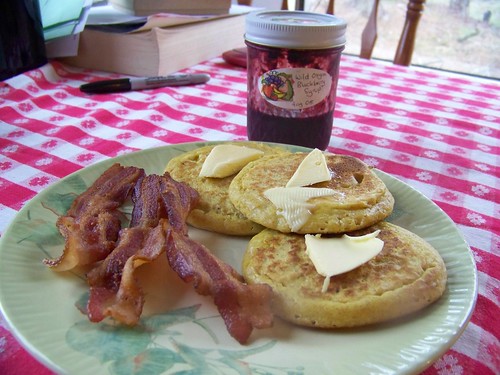 That doesn't mean it's easy to implement.
That doesn't mean it's easy to implement.
But then I found a recipe that makes it easy. Last year I was introduced to Sue Gregg's blender batter method of making pancakes and waffles. She uses a blender to grind a mix of whole grains and fermented milk into a slurry that becomes the batter to make your pancakes or quick bread. The more I experiment with this technique, the more I love it. I'm going to write out how I make pancakes here, but I highly recommend that you go visit Sue Gregg's site. She has lots of information, her original recipes and links to buy her books (anyone looking to buy me a birthday present? Yeah, email me, I'll send you my address :)
Her site is here: http://www.suegregg.com/
1 cup whole grain*
1 cup kefir, buttermilk or yogurt thinned to the consistency of buttermilk
1 tbs (or more) liquid fat - melted butter or coconut oil, olive oil, etc.
1 egg
1/4 tsp baking soda
1/2 tsp salt
1 tsp baking powder
up to 1 tsp vanilla extract and/or sweetner of your choice (optional)
The night before you want to make pancakes combine the grain and the milk in your blender. Using the pulse button start to grind the mixture. When the mixture starts to m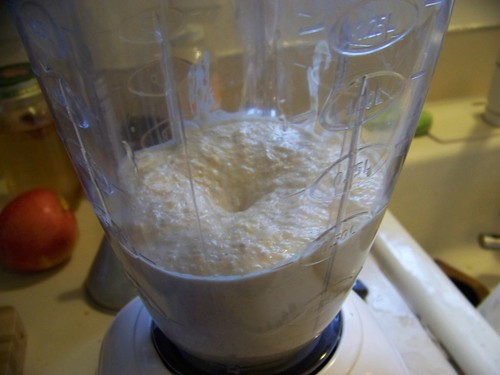 ake a nice vortex in the middle let it run and grind the grains. Sue has you grind it for a full 3 minutes. I usually don't let my cheap blender run that long continuously and even if it doesn't grind the whole 3 minutes it seems to work just fine. Grind it for as long as you can stand it. If it doesn't make a vortex you can add a little more liquid, but do so sparingly. Chances are you have enough liquid and if you add more your pancake batter will be too loose.
ake a nice vortex in the middle let it run and grind the grains. Sue has you grind it for a full 3 minutes. I usually don't let my cheap blender run that long continuously and even if it doesn't grind the whole 3 minutes it seems to work just fine. Grind it for as long as you can stand it. If it doesn't make a vortex you can add a little more liquid, but do so sparingly. Chances are you have enough liquid and if you add more your pancake batter will be too loose.
Let the mixture of grain and milk sit on the counter for a couple hours or overnight. If your blender is nicer than mine you can just leave it in the blender jar. Mine leaks at the bottom so I scrape everything into a bowl and let it sit on the counter.
In the morning grind the grain/milk mixture again to loosen everything up. Since I probably didn't grind it a full 3 minutes the night before I give it a good grind first thing in the morning. Add the egg and grind it some more. With the blender running ad d the melted fat. This keeps the fat from clumping when it hits the colder batter. Add the optional sweetner or vanilla.
d the melted fat. This keeps the fat from clumping when it hits the colder batter. Add the optional sweetner or vanilla.
When you are ready to cook the pancakes (heat up you cast iron skillet, melt a bunch of coconut oil or butter in it, get everything hot, cook your bacon, etc) add the salt and leaveners. Again, do this while the blender is running to avoid clumping.
Cook your pancakes as usual, being sure to give the first one to the dog. That's traditional, remember? :)
*The cool thing about this recipe is that you can use ANY grain you want. The gluten in wheat is not very important when making pancakes so even if you aren't "gluten free"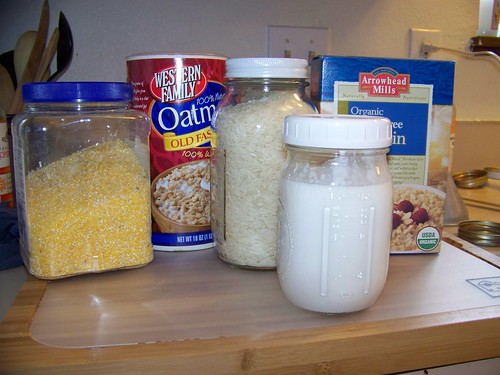 you can make these that much more healthy by using gluten free grains. I usually use a mix of oats (steel cut or rolled), brown rice (or white), wheat berries, cornmeal, and whatever else I have around. I like adding a tablespoon or more of sesame seeds to the mix and have been known to use my Arrowhead Mills 7 Grain Gluten Free Hot Cereal. Toasted buckwheat, or kasha, makes an amazing pancake! Quinoa, barley, amaranth, kamut, millet - whatever you have or like, use it! Just use one cup total of whatever grains you like.
you can make these that much more healthy by using gluten free grains. I usually use a mix of oats (steel cut or rolled), brown rice (or white), wheat berries, cornmeal, and whatever else I have around. I like adding a tablespoon or more of sesame seeds to the mix and have been known to use my Arrowhead Mills 7 Grain Gluten Free Hot Cereal. Toasted buckwheat, or kasha, makes an amazing pancake! Quinoa, barley, amaranth, kamut, millet - whatever you have or like, use it! Just use one cup total of whatever grains you like.
These pancakes rock. No one would ever guess that they were whole seeds and fermented milk a mere 6 hours before. They generally don't have a "whole grain" texture, are light and fluffy, and incredibly flavorful. You can vary them any number of ways by adding berries or nuts, changing the grains, changing the sweetner and of course changing the toppings. I personally love jam and yogurt, but won't turn down a pancake with butter and maple syrup either.
I recently used this method to make a cornbread and am excited about branching out into other quick breads and muffins. The batter could also make crepes/tortilla-like-wraps if made thinner. I generally make a double batch and freeze the extras for quick breakfasts later on.
I just can't say enough good about this recipe and method. Give it a try, seriously. It's so versatile, and you feel so accomplished. "I used whole grains, soaked them and I can have a real breakfast all week!"
Most of us in America grew up on some variation of fluffy, sweet, soft bread and pastries. My mom made sure we ate wheat bread, but it was as fluffy as the Wonder Bread my friends ate. And we certainly got bisquick pancakes, doughnuts, and white rice. As I learned more about nutrition I learned of the benefits of whole grains - increased fiber and increased nutrients. Then came Nourishing Traditions and their instructions for soaking or sprouting grains. Whoa - this is getting a bit heavy.
I'll be the first to admit that soaking or sprouting grains before consuming them is low on my priority list. I understand the benefits of reducing anti nutrients, increasing digestability and all of that. It makes perfect sense. Heck, I even believe that grains don't need to be the base of our diet. Humans have only been eating grains for a couple thousand years, compared with meat and vegetables which we have been eating since before we were even humans.
 That doesn't mean it's easy to implement.
That doesn't mean it's easy to implement.But then I found a recipe that makes it easy. Last year I was introduced to Sue Gregg's blender batter method of making pancakes and waffles. She uses a blender to grind a mix of whole grains and fermented milk into a slurry that becomes the batter to make your pancakes or quick bread. The more I experiment with this technique, the more I love it. I'm going to write out how I make pancakes here, but I highly recommend that you go visit Sue Gregg's site. She has lots of information, her original recipes and links to buy her books (anyone looking to buy me a birthday present? Yeah, email me, I'll send you my address :)
Her site is here: http://www.suegregg.com/
Blender Batter Pancakes
1 cup whole grain*
1 cup kefir, buttermilk or yogurt thinned to the consistency of buttermilk
1 tbs (or more) liquid fat - melted butter or coconut oil, olive oil, etc.
1 egg
1/4 tsp baking soda
1/2 tsp salt
1 tsp baking powder
up to 1 tsp vanilla extract and/or sweetner of your choice (optional)
The night before you want to make pancakes combine the grain and the milk in your blender. Using the pulse button start to grind the mixture. When the mixture starts to m
 ake a nice vortex in the middle let it run and grind the grains. Sue has you grind it for a full 3 minutes. I usually don't let my cheap blender run that long continuously and even if it doesn't grind the whole 3 minutes it seems to work just fine. Grind it for as long as you can stand it. If it doesn't make a vortex you can add a little more liquid, but do so sparingly. Chances are you have enough liquid and if you add more your pancake batter will be too loose.
ake a nice vortex in the middle let it run and grind the grains. Sue has you grind it for a full 3 minutes. I usually don't let my cheap blender run that long continuously and even if it doesn't grind the whole 3 minutes it seems to work just fine. Grind it for as long as you can stand it. If it doesn't make a vortex you can add a little more liquid, but do so sparingly. Chances are you have enough liquid and if you add more your pancake batter will be too loose.Let the mixture of grain and milk sit on the counter for a couple hours or overnight. If your blender is nicer than mine you can just leave it in the blender jar. Mine leaks at the bottom so I scrape everything into a bowl and let it sit on the counter.
In the morning grind the grain/milk mixture again to loosen everything up. Since I probably didn't grind it a full 3 minutes the night before I give it a good grind first thing in the morning. Add the egg and grind it some more. With the blender running ad
 d the melted fat. This keeps the fat from clumping when it hits the colder batter. Add the optional sweetner or vanilla.
d the melted fat. This keeps the fat from clumping when it hits the colder batter. Add the optional sweetner or vanilla.When you are ready to cook the pancakes (heat up you cast iron skillet, melt a bunch of coconut oil or butter in it, get everything hot, cook your bacon, etc) add the salt and leaveners. Again, do this while the blender is running to avoid clumping.
Cook your pancakes as usual, being sure to give the first one to the dog. That's traditional, remember? :)
*The cool thing about this recipe is that you can use ANY grain you want. The gluten in wheat is not very important when making pancakes so even if you aren't "gluten free"
 you can make these that much more healthy by using gluten free grains. I usually use a mix of oats (steel cut or rolled), brown rice (or white), wheat berries, cornmeal, and whatever else I have around. I like adding a tablespoon or more of sesame seeds to the mix and have been known to use my Arrowhead Mills 7 Grain Gluten Free Hot Cereal. Toasted buckwheat, or kasha, makes an amazing pancake! Quinoa, barley, amaranth, kamut, millet - whatever you have or like, use it! Just use one cup total of whatever grains you like.
you can make these that much more healthy by using gluten free grains. I usually use a mix of oats (steel cut or rolled), brown rice (or white), wheat berries, cornmeal, and whatever else I have around. I like adding a tablespoon or more of sesame seeds to the mix and have been known to use my Arrowhead Mills 7 Grain Gluten Free Hot Cereal. Toasted buckwheat, or kasha, makes an amazing pancake! Quinoa, barley, amaranth, kamut, millet - whatever you have or like, use it! Just use one cup total of whatever grains you like.These pancakes rock. No one would ever guess that they were whole seeds and fermented milk a mere 6 hours before. They generally don't have a "whole grain" texture, are light and fluffy, and incredibly flavorful. You can vary them any number of ways by adding berries or nuts, changing the grains, changing the sweetner and of course changing the toppings. I personally love jam and yogurt, but won't turn down a pancake with butter and maple syrup either.
I recently used this method to make a cornbread and am excited about branching out into other quick breads and muffins. The batter could also make crepes/tortilla-like-wraps if made thinner. I generally make a double batch and freeze the extras for quick breakfasts later on.
I just can't say enough good about this recipe and method. Give it a try, seriously. It's so versatile, and you feel so accomplished. "I used whole grains, soaked them and I can have a real breakfast all week!"
Subscribe to:
Posts (Atom)